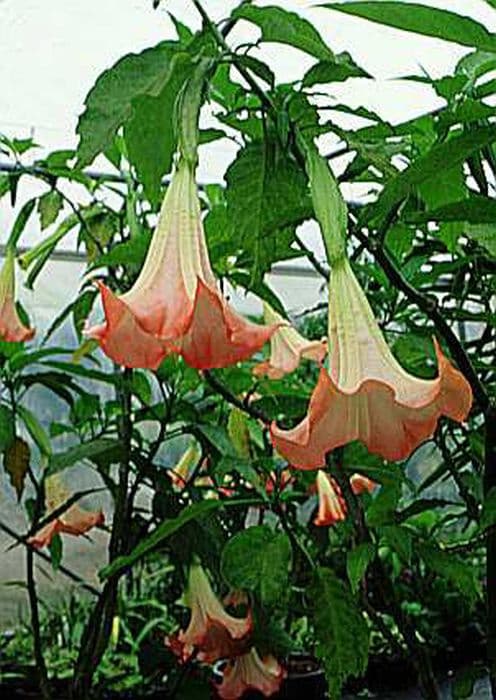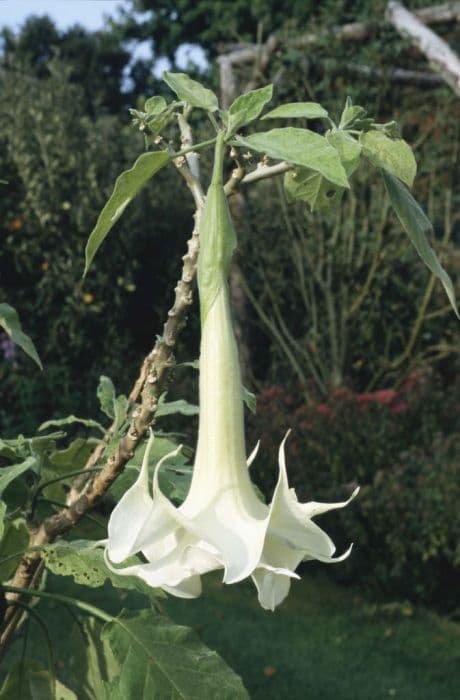Million Bells Calibrachoa Caloha Classic Blue Velvet (Caloha Classic Series)
![calibrachoa [Caloha Classic Blue Velvet]](/_next/image?url=https%3A%2F%2Fplants-admin.emdemapps.com%2Fimages%2Fplants%2F%2Fimages%2F604b604884a75.png&w=3840&q=75)
ABOUT
Calibrachoa Caloha Classic Blue Velvet, commonly known as "million bells," is a visually captivating plant that showcases a profusion of petunia-like flowers. The striking blooms of this cultivar feature a luxurious deep blue color that resembles the texture and appearance of soft velvet. Each flower presents a small, yellow center that provides an alluring contrast to the blue petals, enhancing its visual appeal. The plant itself is characterized by its lush, green foliage, composed of small to medium-sized leaves that create a verdant backdrop for the display of flowers. The leaves have a smooth texture and an ovate to oblong shape, which contributes to the overall density and bushiness of the plant. The million bells is an abundant bloomer, and the flowers have a funnel shape which is typical of the species, adding to their charm when they cascade or spill over the edges of containers or hanging baskets. Its growth habit tends to be trailing or spreading, which makes it an ideal choice for adding a splash of color and texture to garden beds and as an ornamental feature in outdoor living spaces. As the blooming season progresses, the plant becomes covered with the eye-catching blue flowers, creating a continuous show of color that is truly enchanting.
About this plant
 Names
NamesFamily
Solanaceae
Synonyms
Million Bells, Mini Petunia
Common names
Calibrachoa Caloha Classic Blue Velvet.
 Toxicity
ToxicityTo humans
Calibrachoa, commonly known as Million Bells, is not known to be toxic to humans. However, as with any plant, sensitivity varies by individual, and ingesting plant material may cause mild gastrointestinal discomfort in some people. It is generally advised to avoid eating ornamental plants.
To pets
Calibrachoa, often referred to as Million Bells, is generally considered to be non-toxic to pets. However, gastrointestinal upset may occur if pets ingest a significant amount of the plant, as it is not part of their natural diet. Symptoms could include vomiting, diarrhea, or drooling. If you notice any adverse reactions after ingestion, it is recommended to contact a veterinarian.
 Characteristics
CharacteristicsLife cycle
Annuals
Foliage type
Evergreen
Color of leaves
Green
Flower color
Blue
Height
1 feet (30 cm)
Spread
2 feet (60 cm)
Plant type
Herb
Hardiness zones
9
Native area
South America
Benefits
 General Benefits
General Benefits- Vibrant Color: Adds striking blue-purple color to gardens and landscapes.
- Continuous Blooming: Produces flowers from spring to fall for extended garden interest.
- Low Maintenance: Requires minimal care beyond regular watering and occasional fertilization.
- Drought Tolerant: Once established, it can tolerate dry conditions.
- Compact Growth: Ideal for small spaces and containers due to its mounding growth habit.
- Attracts Pollinators: Draws in bees and butterflies, supporting local ecosystems.
- Frost Resistant: Can withstand light frosts, making it versatile in different climates.
 Medical Properties
Medical PropertiesThis plant is not used for medical purposes.
 Air-purifying Qualities
Air-purifying QualitiesThis plant is not specifically known for air purifying qualities.
 Other Uses
Other Uses- Photography Backdrops: The intense blue of Calibrachoa flowers can create visually striking backgrounds for macro photography or portrait shots.
- Art Inspiration: Artists can use the vibrant blue petals as inspiration for paintings, textiles, or color palettes in various art projects.
- Educational Tool: Educators can use Calibrachoa plants in lessons about pollination, plant growth, and garden ecosystems for students of all ages.
- Homemade Potpourri: Dried Calibrachoa flowers can be included in homemade potpourri mixtures for a subtle floral scent in the home.
- Event Decor: Calibrachoa can add a touch of elegance to event decors such as garden parties, weddings, or corporate events.
- Craft Projects: The flowers can be used in DIY craft projects like scrapbooking, card making, or decoupage works.
- Color Therapy: The soothing blue color of the flower could be used for chromotherapy settings to create a calm and peaceful environment.
- Journaling: Pressed Calibrachoa flowers can be used as embellishments in bullet journals or planners to add natural beauty to the pages.
- Fairy Gardens: Small and compact, these plants can be used to create enchanting fairy garden displays for children and adults alike.
- Garden Photography Workshops: The eye-catching Calibrachoa can be a subject in photography workshops, honing skills in capturing floral and garden beauty.
Interesting Facts
 Feng Shui
Feng ShuiThe Million Bells is not used in Feng Shui practice.
 Zodiac Sign Compitability
Zodiac Sign CompitabilityThe Million Bells is not used in astrology practice.
 Plant Symbolism
Plant Symbolism- Grace: The Calibrachoa, with its delicate, velvet-like petals, often symbolizes grace and gentleness, reflecting the effortless beauty found in nature.
- Endurance: As a plant that can thrive in various conditions, Calibrachoa represents the ability to endure and adapt to life's changes.
- Patience: The growth habit of Calibrachoa, requiring time to fully blossom and display its beauty, can be seen as a symbol of patience.
- Attraction: With its striking blue hues, the Calibrachoa is symbolic of attraction, capturing attention and drawing interest.
 Water
WaterMillion Bells should be watered thoroughly whenever the top inch of soil feels dry to the touch. In warmer weather, this might mean watering daily, especially if the plant is in a hanging basket or a container where soil dries out more quickly. Aim to provide about a gallon of water per week, adjusting for rainfall and temperature, being careful not to overwater. Always ensure that the container has good drainage to prevent root rot. During cooler months, the watering frequency should be reduced as the plant requires less moisture.
 Light
LightMillion Bells thrive in full sun, so the best spot for growing this plant is in a location where it receives at least 6 to 8 hours of direct sunlight daily. They can tolerate partial shade, but flowering may be reduced in less light. Ensure the plant is protected from extreme afternoon sun if you live in a hot climate, as this can scorch the leaves and flowers.
 Temperature
TemperatureMillion Bells prefer moderate to warm temperatures, thriving best between 55 to 85°F. While they can survive in temperatures down to around 35°F, they are sensitive to frost and should be protected or brought indoors if the temperature threatens to drop below freezing. The ideal growing conditions are daytime temperatures around 70°F and slightly cooler temperatures at night.
 Pruning
PruningPrune Million Bells to maintain their shape and encourage bushier growth with more flowers. Trim back the stems every few weeks, removing about 20% of the plant's length to stimulate new growth. The best time for pruning is in the late spring or early summer, but you can also lightly prune throughout the growing season to remove dead or faded blooms and encourage continuous flowering.
 Cleaning
CleaningAs needed
 Soil
SoilMillion Bells, or Calibrachoa, thrives in a well-draining, peat-based potting mix with a pH of 5.5 to 6.0. A mix of 50% peat, 25% pine bark, and 25% perlite or pumice is ideal. Regular feeding is necessary due to the fast-draining nature of the soil.
 Repotting
RepottingMillion Bells should be repotted every year in the spring. These vigorous plants benefit from fresh soil and more room for their rapidly growing roots.
 Humidity & Misting
Humidity & MistingMillion Bells prefers moderate humidity levels, ranging from 40% to 70%, which mimic their native environment and support their abundant flowering.
 Suitable locations
Suitable locationsIndoor
Ensure bright light, well-draining soil, and weekly watering.
Outdoor
Place in full sun, use well-draining mix, water regularly.
Hardiness zone
9-11 USDA
 Life cycle
Life cycleCalibrachoa Caloha Classic Blue Velvet, commonly known as Million Bells, typically starts its life cycle from seed or vegetative cuttings, with germination occurring in warm, moist conditions. The seedlings develop into young plants with distinctive small, trumpet-shaped blue flowers and begin a rapid growth phase during which they require ample sunlight, water, and nutrients. As they mature, they enter the flowering stage, where they bloom profusely throughout the warm months, making them popular for hanging baskets and container gardens. After flowering, the plant sets seed if pollinators are present, although many cultivated varieties are sterile and will not produce viable seeds. When temperatures drop in autumn or during the onset of adverse conditions, the plant will begin to senesce and may die back, particularly if it encounters frost, as they are sensitive to cold. In perennial growing zones, or if protected from frost, they can overwinter and regrow the following spring, continuing the cycle.
 Propogation
PropogationPropogation time
Spring-Summer
Propogation: The most popular method of propagating the Calibrachoa Caloha Classic Blue Velvet is through softwood cuttings. This is typically done in spring when the plant is experiencing active growth. To propagate, growers cut a healthy stem of about 4 to 6 inches (10 to 15 cm) in length, making sure it has several sets of leaves. The lower leaves are removed, and the cut end is dipped in rooting hormone to encourage root development. The cutting is then placed in a well-draining potting mix and kept moist until roots have established, which usually occurs within a few weeks. Indirect light and consistent humidity can assist in successful rooting.


![Calibrachoa [Aloha Classic Blue Sky]](/_next/image?url=https%3A%2F%2Fplants-admin.emdemapps.com%2Fimages%2Fplants%2F%2Fimages%2F604b636c3778b.png&w=640&q=75)
![Calibrachoa [Aloha Classic Gold]](/_next/image?url=https%3A%2F%2Fplants-admin.emdemapps.com%2Fimages%2Fplants%2F%2Fimages%2F604b6284c573e.png&w=640&q=75)
![Calibrachoa [Aloha Classic Tiki Soft Pink]](/_next/image?url=https%3A%2F%2Fplants-admin.emdemapps.com%2Fimages%2Fplants%2F%2Fimages%2F604b548e0a5ef.png&w=640&q=75)
![Calibrachoa [Cabaret Deep Yellow]](/_next/image?url=https%3A%2F%2Fplants-admin.emdemapps.com%2Fimages%2Fplants%2F%2Fimages%2F604b5f20ca3ef.png&w=640&q=75)
![Calibrachoa [Calibasket Radiant Orange]](/_next/image?url=https%3A%2F%2Fplants-admin.emdemapps.com%2Fimages%2Fplants%2F%2Fimages%2F604b536d43cb2.png&w=640&q=75)
![Calibrachoa [Caloha Classic Honey White]](/_next/image?url=https%3A%2F%2Fplants-admin.emdemapps.com%2Fimages%2Fplants%2F%2Fimages%2F604b5f56e0beb.png&w=640&q=75)
![Calibrachoa [Caloha Classic Yellow Chocolate Ring]](/_next/image?url=https%3A%2F%2Fplants-admin.emdemapps.com%2Fimages%2Fplants%2F%2Fimages%2F604b538aede95.png&w=640&q=75)
![Calibrachoa [Caloha Grand Purple]](/_next/image?url=https%3A%2F%2Fplants-admin.emdemapps.com%2Fimages%2Fplants%2F%2Fimages%2F604b6192993d2.png&w=640&q=75)